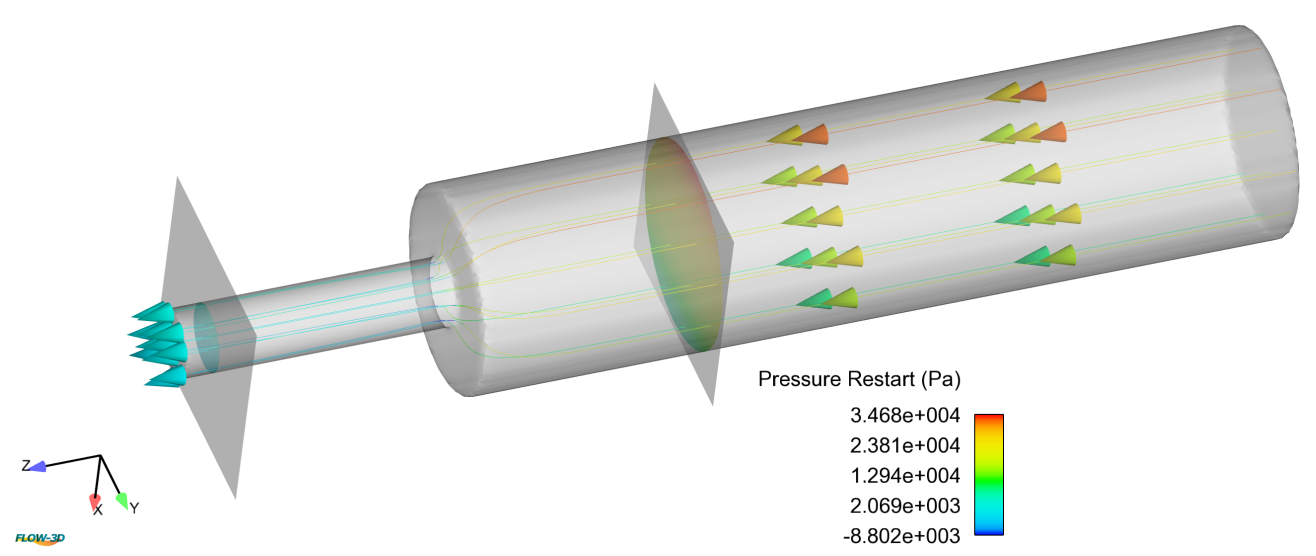
Immersed Boundary Condition
The accurate prediction of forces and energy losses is crucial in the success of modeling many engineering problems such as discharge from an orifice plate, flow past an obstacle and flow in a sudden contraction pipe. Since the fractional cell area and volume method FAVOR™ was introduced more than 30 years ago, the standard solver in FLOW-3D has used a simple method to approximate momentum fluxes near walls (Hirt and Sicilian 1985). When computing the momentum advection term near walls or free surfaces, any spatial velocity derivative that requires velocity values located within solid or void regions is set to zero to eliminate the appearance of numerical boundary layers. From a physical point of view, this method applies a free-slip (non-penetration) boundary condition to the advection at walls, suppressing the artificial boundary layer (Hirt 1993). The loss of flux in the momentum equation is compensated by the pressure. In certain situations, the portion of pressure to compensate for the flux loss grows in time, and may result in a numerical instability called “secular instability,” which is expressed as a monotonic growth of velocities. In order to prevent this instability from developing, an empirical technique has been used to “correct” the flux at the location where the instability may emerge. However, this approach does not resolve the flux loss from the source, and could occasionally introduce a nonphysical behavior of the solution such as pressure oscillations.
A technique for approximating the advection term based on the ghost-cell immersed boundary method (Mittal et al. 2008) has been developed for FLOW-3D v12.0. The immersed boundary method technique provides more accurate pressure and force predictions near walls. The ghost-cell immersed boundary method has emerged in recent years as an enhanced boundary treatment in conventional Cartesian grid approximations in problems involving complex geometries. Since the method is only a means to handle boundaries, it can be easily added as a model into the existing FLOW-3D solver with relatively few changes to the underlying solver structure, and is compatible with other physical models in FLOW-3D. It uses a weighted-average probe technique in conjunction with various interpolation methods to handle different geometry configurations. The new model works for flows with 3D mesh blocks or hybrid 3D/shallow water mesh blocks, but not for shallow water meshes alone.
Immersed Boundary Method Results
A simple example of the new Immersed Boundary Method model is the discharge of water from a 1m-diameter circular orifice. The water container is 10m long by 10m wide, and the initial elevation of the water surface to the center of the orifice is 6m. The drop of the elevation, h, and the volume flow rate at the orifice, Q, follow the quadratic and linear curves, respectively, as shown in the animation. Based on the equation $latex {{C}_{d}}=\frac{{4Q}}{{\pi {{d}^{2}}\sqrt{{2gh}}}}$, the average coefficient of discharge Cd for the simulation is 0.660, which is about 8% larger than the asymptotic value of 0.611 (Swamee and Swamee, 2010).
Another example is the calculation of the total resistance force on a NAVY vessel model hull. In this case, the hull length is 5.72m, and the draft is 0.248m. Based on the hull length and mean flow velocity of 2.10m/s, the Reynolds number in the simulation is approximately 12×106. Because the problem is symmetric, only half of the hull is modeled. The computational domain is 30m long by 8m wide and 5.5m deep. The experimentally obtained average total resistance force for half of the hull is 22.62N (Larsson et al. 2003). The average force was 22.43N, only 0.8% lower for the immersed boundary solver. In addition, the immersed boundary solver finished in about 40 hours, which is 8 hours faster than the standard solver.
References
Hirt, C., & Sicilian, J. (1985). A porosity technique for the definition of obstacles in rectangular cell meshes. International Conference on Numerical Ship Hydrodynamics, 4th. Washington, D.C.
Hirt, C. (1993). Volume-fraction techniques: powerful tools for wind engineering. Journal of Wind Engineering and Industrial Aerodynamics, 46 & 47, 327-338.
Mittal, R., Dong, H., Bozkurttas, M., Najjar, F., Vargas, A., & von Loebbecke, A. (2008). A versatile sharp interface immersed boundary method for incompressible flows with complex boundaries. Journal of computational physics, 227(10), 4825-4852.
Swamee, P., & Swamee , N., (2010). Discharge equation of a circular sharp-crested orifice. Journal of Hydraulic Research, 48(1), 106-107.

